10 April, 2000
LTER Phytoplankton Group; Part 2
Question 51: What is the coldest temperature ever recorded in Antarctica?
Continued from 4/8/00...
The Palmer LTER phytoplankton group collects water samples, nets
phytoplankton and measures properties of water and light on the annual LTER
ocean cruise and at 10 stations in the Palmer area during the summer season.
They monitor the phytoplankton, looking at what species are present, where
they are and how they are doing throughout the season. By examining
conditions and phytoplankton in the field and carrying out experiments in the
lab, they hope to discover the processes controlling the space/time
variability of phytoplankton biomass and production.
After the water-column samples are collected with the Zodiac, (see journal
entry from 3/19) the water is brought back to the lab. Some water is filtered
and the phytoplankton identified by pigment analysis and photomicroscopy.
They also look at nutrient content (nitrate, phosphate and silicate etc.) of
the sea water and ship home water-column samples. Meg Duffey uses the
phytoplankton from the water samples to set up controlled experiments looking
at rates of primary production at different light levels.
Meg is one of the technicians working with the project this year. With a
project spanning ten years, many scientists contribute for a portion of the
time and then move on. Meg has always wanted to come to Antarctica, although
it surprises her that she didn't end up in the Dry Valleys as she usually
works with lakes. She graduated a semester early from her Cornell undergrad
work to come down here on Jan 1. Meg will be starting her Ph.D. work next
year. She would like to come back to Antarctica in the future with her own
project. After three months at Palmer Station, she thinks it will be weird
seeing lots of people around that she doesn't know.
Meg has worked in the most polluted lake in the U.S., a former resort lake
near Syracuse, NY. It not only has more sewage input than any other US lake,
but Allied Chemicals has dumped its waste there for years. At peak operation,
10 kg of mercury was dumped there every day, along with other heavy metals.
To look at the lake's history, the scientists use Daphnia (tiny, fresh water
invertebrates) eggs left in the lake mud for a record. The lake had one set
of species before the heavy pollution and a different set of species
afterwards. Those that could live in the polluted water were most likely
transferred accidentally by the company moving equipment from place to place.
New York represented a huge range extension for the pollution-hardy
species--one is from Europe, another is from the American southwest. Now that
the lake is being cleaned up, the pollution-tolerant species are dying off and
the native species are returning.
Here at Palmer Station, Meg is the radiation lab technician for the LTER.
They only use Carbon 14 (C14), a fairly mild radioactive isotope. Since
radioactive isotopes of chemicals can easily be tracked and observed in the
lab, they are used to quantify biological processes. In the process of
photosynthesizing, the phytoplankton turn inorganic carbon from the
environment into organic material for their bodies. By placing the
phytoplankton in an environment with lots of a radioactive isotope of carbon,
all of the carbon that they fix during photosynthesis is "labeled." When the
incubation time is over, hydrochloric acid is added to remove all C14 that
wasn't incorporated into the phytoplankton. Then the measurement of how much
C14 has been incorporated represents the amount of photosynthesis (primary
production) that has taken place, minus the amount already used up by the
phytoplankton for staying alive (respiration).
The LTER lets these experiments incubate for 24 hours with artificially
altered ambient light levels. This is done in salt water tubes outside the
aquarium building at six different light intensities, the same intensities as
those used in the field collection (1%, 5%, 10%, 30%, 60%, and 100%). The
results create a neat curve that goes up from almost no productivity at 1% to
the greatest amount of productivity from 30% to 60% of ambient light intensity
and then drops off at the other end where photoinhibition (too much light for
the phytoplankton to photosynthesize) occurs at 100%.
Continued on 4/11...
Answer 50: The warmest temperature recorded in Antarctica was 15 degrees C
(59 degrees F). It was recorded on the Antarctic Peninsula, the "Banana Belt"
of Antarctica!
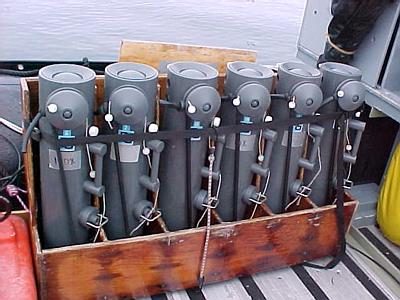
Empty Go-Flo bottles secured on board Bruiser.
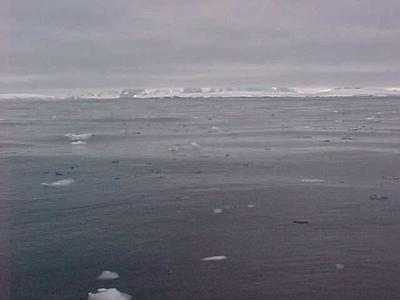
View from LTER small-scale sampling station E.

Minke whales sighted on the way to Station E in March.
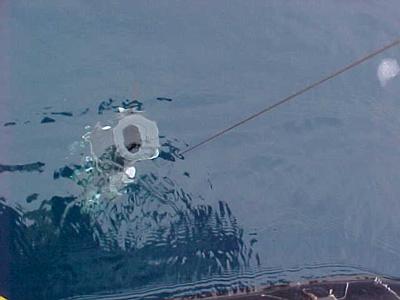
Go-Flo bottle open in water and ready to take 100% light intensity water sample.
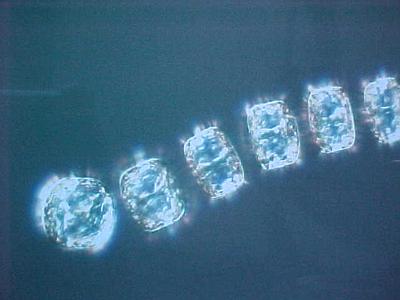
Photomicroscope picture of the diatom Thalassiosira. Filament connecting the sections is not visible.
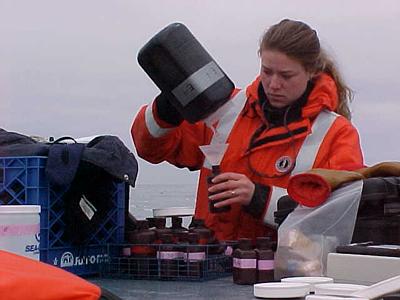
Natacha separating and preparing various treatments of the 30% light intensity water sample.
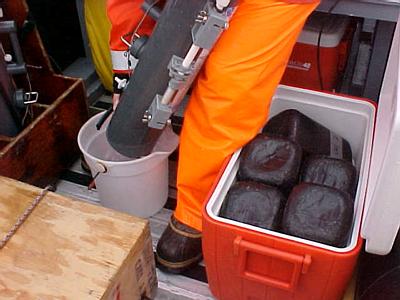
Emptying Go-Flo bottle samples on Bruiser.

Meg on Bruiser measuring light intensity sampling depths.

Contact the TEA in the field at
.
If you cannot connect through your browser, copy the
TEA's e-mail address in the "To:" line of
your favorite e-mail package.
|
